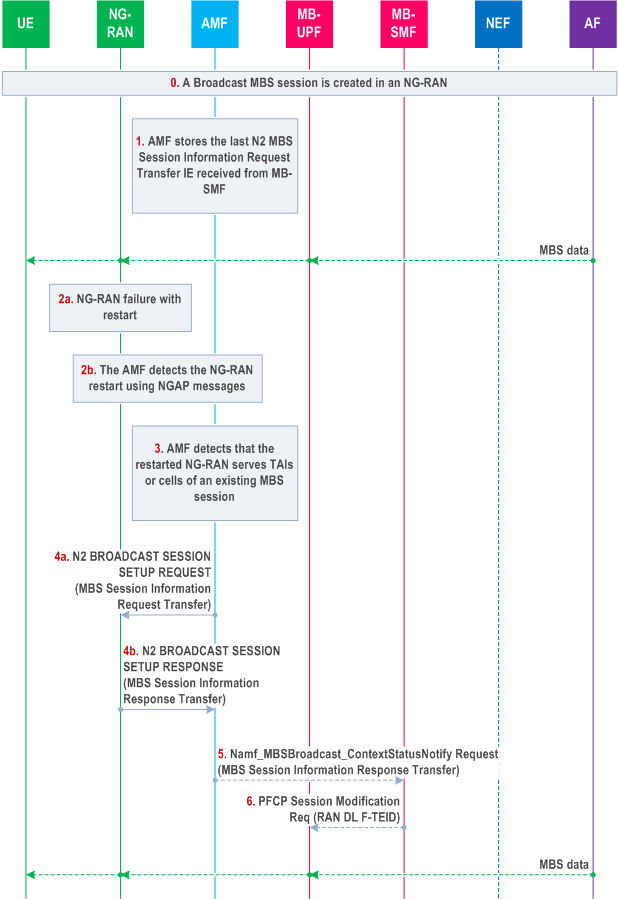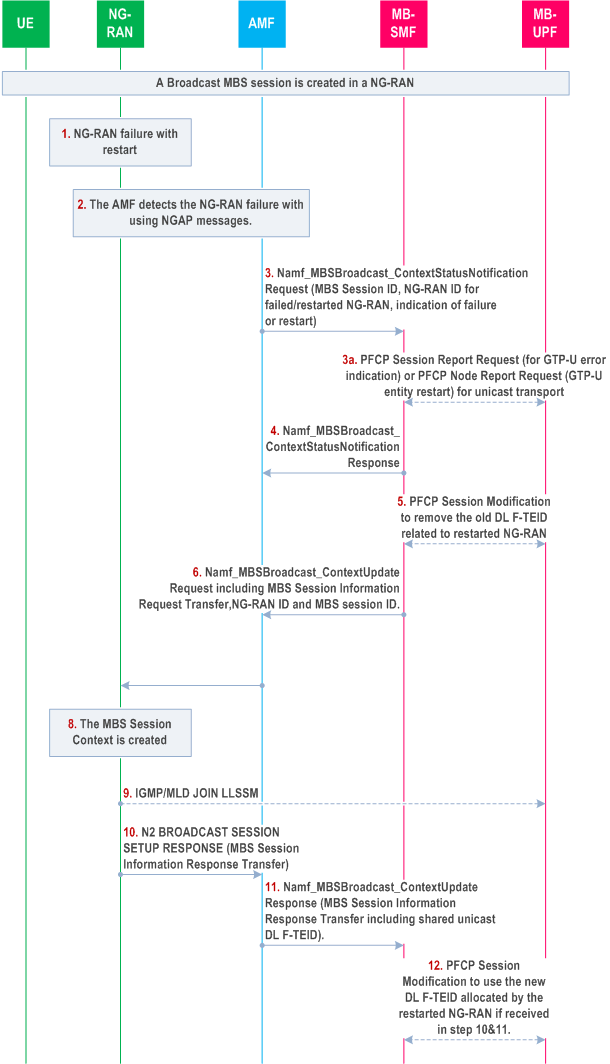Content for TS 23.527 Word version: 19.0.0
8.3 Restoration procedures for NG-RAN failure with or without restart
8.3.1 General
8.3.2 Broadcast MBS session restoration Procedure for NG-RAN failure with restart
8.3.2.1 General
8.3.2.2 Broadcast MBS session restoration by AMF
8.3.2.3 Broadcast MBS session restoration by MB-SMF
...
...
8.3 Restoration procedures for NG-RAN failure with or without restart p. 41
8.3.1 General p. 41
When an NG-RAN fails with or without restart, all its MBS session contexts may be lost, causing the interruption in the delivery of MBS data over the radio interface.
Restoration procedures for NG-RAN failure with or without restart are optional to support.
8.3.2 Broadcast MBS session restoration Procedure for NG-RAN failure with restart p. 41
8.3.2.1 General p. 41
MBS sessions affected by an NG-RAN failure with restart may be restored by the AMF as specified in clause 8.3.2.2 or by the MB-SMF as specified in clause 8.3.2.3.
8.3.2.2 Broadcast MBS session restoration by AMF p. 41
The procedure specified in this clause may be supported to restore a broadcast MBS session affected by an NG-RAN restart.
The AMF handling a broadcast MBS session is responsible for restoring the MBS session in a restarted NG-RAN, as shown in Figure 8.3.2.2-1.

Step 1.
The AMF stores the last N2 MBS SM container (i.e. MBS Session Setup or Modification Request Transfer IE defined in TS 38.413) received from the MB-SMF during the establishment of the broadcast MBS session or during a broadcast MBS session update. When unicast transport is used over N3mb, the MB-SMF stores the RAN-ID together with the DL F-TEID received from each NG-RAN.
Step 2.
The NG-RAN restarts, causing the broadcast MBS service interruption.
Step 3.
The AMF detects that the NG-RAN has restarted (e.g. upon receiving NG Setup Request message) and that it serves at least one TAI or one cell being part of the MBS service area of an existing MBS session (or one of the MBS services areas of the MBS session in case of location dependent content).
Step 4.
The AMF re-establishes the broadcast MBS session in the restarted NG-RAN, by sending an NGAP Broadcast Session Setup Request including the last N2 (NGAP) MBS Session Setup or Modification Request Transfer IE that was stored.
The NG-RAN establishes the broadcast MBS session and returns a response to the AMF. If unicast transport is used over N3mb, the NG-RAN response includes the DL F-TEID assigned by the NG-RAN to receive the MBS data from the MB-UPF within the N2 (NGAP) MBS Session Setup or Modification Response Transfer IE of the NGAP Broadcast Session Setup Response message. In deployments where multiple NG-RAN nodes share a common user plane entity and unicast transport is used over N3mb, the NG-RAN response may include an existing DL F-TEID signalled by other NG-RAN nodes during shared delivery setup.
The NG-RAN joins the delivery of the broadcast MBS session if multicast transport is used over N3mb.
Step 5.
If an N2 MBS SM Container (i.e. N2 (NGAP) MBS Session Setup or Modification Response Transfer IE) was received from the NG-RAN in step 4, the AMF sends an Namf_MBSBroadcast_ContextStatusNotify Request to the MB-SMF including the N2 MBS SM Container and the RAN-ID of the NG-RAN.
Step 6.
The MB-SMF modifies the PFCP session of the MBS session in the MB-UPF to start distributing MBS data towards the DL GTP-U F-TEID received from the NG-RAN, and to stop doing so towards the earlier DL GTP-U F-TEID that was used by the same NG-RAN before the NG-RAN restart.
This step shall be skipped in deployments where multiple NG-RAN nodes share a common user plane entity, unicast transport is used over N3mb, and the MB-SMF that supports handling shared NG-U terminations determines that the DL F-TEID signalled by restarted NG-RAN node is already associated with other NG-RAN nodes.
8.3.2.3 Broadcast MBS session restoration by MB-SMF p. 43
The procedure specified in this clause may be supported to restore a Broadcast MBS session affected by an NG-RAN restart.
When the AMF detects an NG-RAN restart, or a (new) NG-RAN is deployed to serve a TAI that is part of the MBS session service area, e.g. using NG Setup Request message, as specified in TS 38.413, it shall report such event to the MB-SMF for each of MBS session(s) affected by this event, to enable the MB-SMF to (re)start the MBS session(s) in the concerning NG-RAN as further described in the Figure 8.3.2.3-1.
The MB-SMF shall run the following restoration procedure for each of Broadcast MBS sessions which were established in the restarted NG-RAN or a (new) NG-RAN.

Step 1.
The NG-RAN has failed with restart.
Step 2.
The AMF detects the NG-RAN has failed with restart, e.g., upon receiving NG Setup Request message.
Step 3.
The AMF sends Namf_MBSBroadcast_ContextStatusNotify Request message to the MB-SMF for each affected MBS session including the MBS Session ID, the NG-RAN ID and an indication of the event, either NG-RAN restart, or NG-RAN failure without restart, or a (new) NG-RAN getting into service to serve a TAI that is part of the MBS session service area.
Step 3a.
The MB-SMF receives a PFCP Node Report Request message from the MB-UPF to report NG-RAN has failed with restart or a PFCP Session Report Request message from the MB-UPF to report receiving GTP-U Error Indication for each affected MBS session when unicast transport was used for N3mb interface.
Step 4.
The MB-SMF returns a "204 No Content" response.
Step 5.
The MB-SMF modifies the PFCP sessions corresponding to the affected MBS sessions to remove the NG-RAN DL F-TEID for unicast transport over N3mb.
Step 6.
The MB-SMF sends Namf_MBSBroadcast_ContextUpdate Request message to the AMF to (re)start the MBS session in the related NG-RAN including the MBS Session Setup or Modification Request Transfer IE and the NG-RAN ID received in the step 3.
If the notification is triggered due to receiving the PFCP Node Report Request message or the PFCP Session Report Request message from the MB-UPF as specified in step 3a, and the MB-SMF that supports handling shared NG-U terminations determines that multiple NG-RAN nodes share the restarted user plane entity, the Namf_MBSBroadcast_ContextUpdate Request message may include multiple corresponding NG-RAN IDs.
Step 7.
The AMF sends the N2 MBS Session Setup Request message to the NG-RAN node(s) including the MBS Session Setup or Modification Request Transfer IE.
Step 8.
The MBS session is created/restored in the NG-RAN node(s).
Step 9.
The NG-RAN node(s) joins the delivery of the broadcast MBS session if multicast transport is used over N3mb.
Step 10.
The NG-RAN node(s) responds with the N2 MBS Session Setup Response message including a MBS Session Setup or Modification Transfer IE if a Shared NG-U Unicast TNL Information needs to be allocated for unicast transport over N3mb interface.
Step 11.
The AMF responds with Namf_MBSBroadcast_ContextUpdate Response message with a MBS Session Setup or Modification Response Transfer IE if received.
Step 12.
The MB-SMF modifies the PFCP sessions corresponding to the MBS sessions to provision the new NG-RAN DL F-TEID if received in step 10.